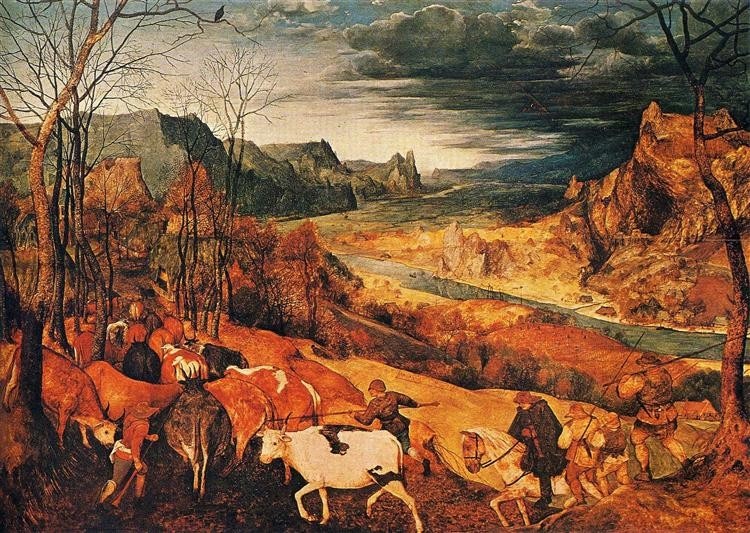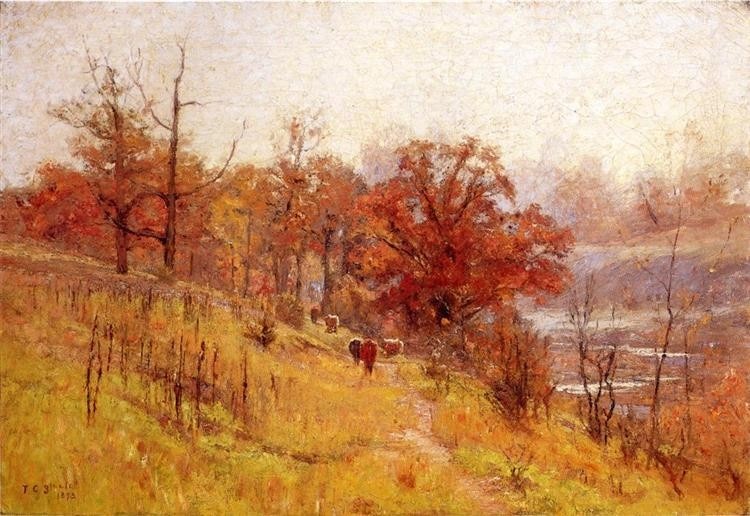The exploration of the cycle of seasons in pictorial art, as an unceasing, mimetic, and interpretative pursuit of reality, provides a rich field of investigation. This recurring theme, a captivating metaphor for cyclical time and the perpetual renewal of nature, allows for an analysis of the ways in which artists, through the masterful use of light, colour, and technique, have translated the fleeting essence of each period of the year onto canvas. Among these, autumn — with its melancholic beauty and inherent symbolic value of decline and transformation — has particularly fascinated artists of every era, finding in November, a month of transition and preparation for the long winter sleep, its fullest expression.
In this period, light — the pivotal element of painting — undergoes a metamorphosis: no longer warm and enveloping as in summer, nor cold and diaphanous as in winter, but raking and golden, generating suggestive and melancholic atmospheres. This light is masterfully captured in works such as Willard Metcalf’s November Morning, where it manifests through large stretches of orange and subtle chromatic variations that outline the foliage, and The Return of the Herd by Pieter Bruegel the Elder, where light caresses the forms with soft, golden touches, creating an atmosphere of suspension and meditative calm.

While in Metcalf, autumn light is the absolute protagonist, in Bruegel it contributes to a broader allegory on time, fate, and the cyclicality of existence. The herd, slowly advancing towards the barns, following an ancestral rhythm, embodies the rhythm of life itself with its inescapable cadence. Man, a tiny figure compared to the vastness of nature, discreetly fits into this cycle, but at the same time plays a significant role. Bruegel, with his keen and participatory gaze, captures the dignity of this simple existence, connected to the land and the rhythms of the seasons, without idealization or picturesque indulgence, but with a deep understanding of the human condition.
A process of transformation, indeed. A necessary step, a slow detachment, to reach a new form of expression, a renewed manifestation of life.
November’s Harmony (1893) by Theodore Clement Steele also translates the intimate essence of the autumn landscape but does so by elevating it to a paradigm of a sensitivity imbued with romantic lyricism. Unlike Bruegel’s more realistic representation, Steele creates a remarkably effective formal reduction, orchestrating a complex chromatic composition through brushwork that is at times vigorous and textured, and at others delicately blended. The palette, dominated by earthy tones, warm browns, golden ochres, and muted greens, helps generate an atmosphere of serene melancholy. The perspective, with the rolling hills fading into the mist and the skeletal trees rising as hieratic forms, contributes to an effect of temporal suspension.

Like in Bruegel, in Steele’s work autumnal nature becomes a meditation on the transience of existence and the relationship between humanity and nature. November’s Harmony fits into the American Romantic tradition, while also anticipating some of the influences of European Symbolism, where nature is not just an object of representation but becomes a projection of emotions, a mirror of the inner self, and a metaphor for the human condition.
Autumn, then. Not just a season in the endless cycle of the year, but a deep archetype, a symbol of that perpetual, inescapable oscillation between the finiteness that defines us and the infinite we long for; between the transience that touches everything and the eternity we seek in its incessant change. A process of transformation, indeed. A necessary step, a slow detachment, to reach a new form of expression, a renewed manifestation of life. The leaves that fall from the branches, surrendering to the wind and the earth; the branches that shed their foliage, revealing their essential structure, their silent strength. Everything speaks of a cycle that is completed, not of an end, but of a prelude to rebirth. To an explosion of life that, after the winter rest, will manifest in new forms, in new colours, in an eternal dance of death and rebirth.
Opening image: Willard Metcalf, November Morning, 1924


